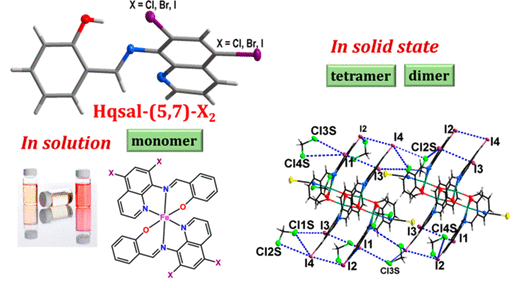A new series of tridentate N-8-quinolyl-salicylaldimine ligands, Hqsal-5,7-X2 [X = Cl(1), Br(2), I(3)], halo-substituted at the 5,7 position of the aminoquinoline moiety and their corresponding complexes with FeIII were synthesized and formulated as [Fe(qsal-5,7-X2)(NCS)(MeO)]2·solv. (X = Cl (1a), Br (2a), I (3a, solv = 1/2MeOH), [Fe4(qsal-5,7-X2)4(NCS)2(MeO)2]·solv. (X = Br (2b), I (3b; solv = 4CH2Cl2)) by single-crystal X-ray diffraction analysis. 1a and 2a are isostructural dimers where each FeIIImetal ion, showing a distorted octahedral environment, is bound by a N,N,O tridentate (qsal-5,7-X2)− (X = Cl and Br) ligand, a N-coordinated SCN– anion, and a bridging methanolate anion. 2b and 3b are centrosymmetric tetramers where each FeIIIis bound by three nitrogen atoms and three oxygen atoms derived from a tridentate (qsal-5,7-X2)− (X = Br and I), a SCN–, a bridging methanolate anion, and a bridging μ2-oxy moiety. In 3b, the iodine atoms dominate the packing interactions through the establishment of a halogen-bonding network. The magnetic behavior of 1a–3a dimers and 2b–3b tetramers indicate the presence of strong antiferromagnetic interactions between FeIII centers (S = 5/2), mediated by the alkoxy bridges. Experimental data can be modeled with an isotropic Hamiltonian, H = −2J(S1 · S2) for dimers (J = −15 cm–1) and H= −2J(S2 · S3) – 2J′(S1 · S2 + S3 · S4), for tetramers (J = −24 cm–1, J′ = −11 cm–1). The magnetic behavior of 1a–3a dimers indicates the presence of strong antiferromagnetic interactions between FeIII centers (S = 5/2), mediated by the alkoxy bridges. 2b and 3b show the same magnetic behavior since they contains analogous bridges between paramagnetic centers, but for a linear tetramer. Density functional theory (DFT) calculations, based on hybrid functional mPW1PW paralleled by the Def2SVP all-electron split-valence basis sets, support the experimental results, showing that monomers could possibly show a spin crossover (SCO) behavior, even though the formation of complexes with an even number of metal ions results in the strong antiferromagnetic interactions. Accordingly, broken symmetry DFT calculations carried out on 1a clearly show that the antiferromagnetic coupling of the two HS FeIII centers results in the lowest energy electron configuration of the complex.
